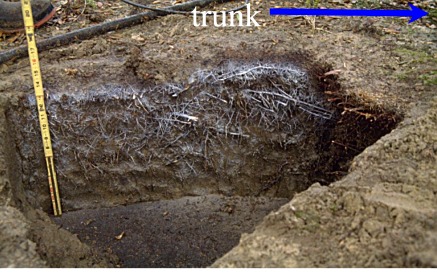Home > Tree structure basics > Root system on trees
Root system on trees

Roots function to hold trees up, store resources, produce growth regulators and absorb water and minerals. Their spread and depth are controlled by the genetics of the tree and soil type and drainage.
Mature trees sometimes have some roots deep in the soil if they are capable of producing deep roots and they are growing on well drained soil. Many of the small diameter fine roots are located close to the soil surface. They are mixed in with turf roots when trees are in a mixed landscape. A large portion of the bigger roots can be close to the soil surface also.
Roots are usually the forgotten part of the tree. They typically comprise from one-third to one-fifth of the total dry weight of the tree. Their tips extend to about three times the edge of the canopy.
Main buttress roots deflected by structures such as rocks, foundations, streets, and sidewalks can reduce the uniformity of the root system and decrease tree stability. Nursery containers and root pruning can also deflect and deform root systems. Deformed root systems sometimes result in unstable trees that can fall over.
Roots damaged or severed during construction or utility installation can also result in tree instability due to loss of upright support, decay and internal defects such as cracks. Trees can become unstable if more than one-third of the main support roots are extensively decayed or missing. Decay often begins on the underside of roots so examine them carefully and thoroughly. A root is considered missing when it has less sound wood than trunk dbh times 0.15.
Damage to main structural roots within five feet of the trunk can result in a decline in health. More importantly, some trees injured in this area do not show symptoms of health decline but they decay and become weak from cracks that form as a result of the injury.

